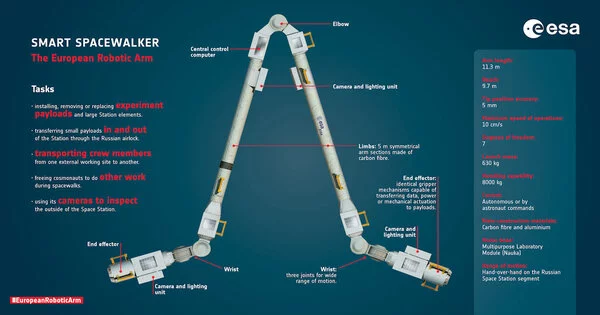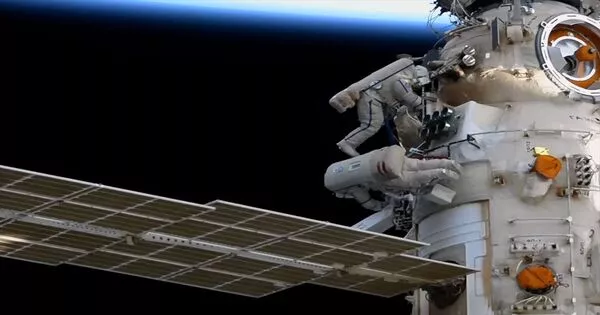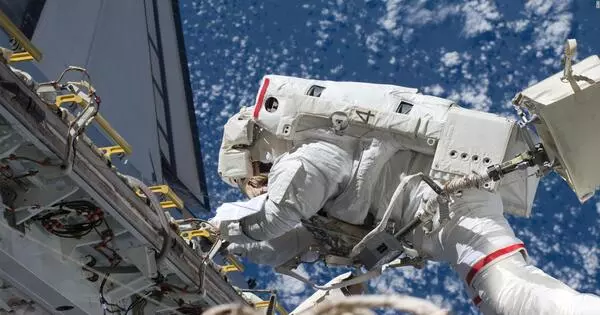Roscosmos flight engineers Oleg Artemyev and Denis Matveev completed their 6-hour, 37-minute spacewalk today at 5:37 p.m. EDT. Russian spacewalk 52 commenced at 11:01 a.m. EDT with the opening of the hatch of the Poisk docking compartment airlock to activate a new robotic arm attached to the Nauka multipurpose laboratory module on the International Space Station.
Today, Russian cosmonauts Artemyev and Matveev achieved their primary objectives by installing and connecting a control panel for the European robotic arm, a 37-foot-long manipulator system fitted to the freshly arrived Nauka multifunctional laboratory module. They also removed the protective covers from Nauka’s arms and fitted railings. The arm will be used to transfer spacewalkers and payloads around the station’s Russian section.

Artemyev was dressed in a Russian Orlan spacesuit with red stripes for this spacewalk. Matveev was dressed in a blue-striped spacesuit. It was Artemyev’s fourth spacewalk and Matveev’s first. It will be the station’s fourth spacewalk in 2022, and the 249th for space station assembly, maintenance, and modifications.
The thermal blankets intended to protect the arm during its July 2021 launch with Nauka will be jettisoned during the next Russian spacewalk, slated for Thursday, April 28. They will also bend the arm’s joints, remove launch constraints, and assess the arm’s capacity to use two grapple fixtures.
Additional spacewalks are planned to complete the European robotic arm’s outfitting and to activate Nauka’s airlock in preparation for future spacewalks.
On Monday’s spacewalk, the cosmonauts erected and linked a control panel near the robotic arm’s base point, then tested the control system, which will be utilized by spacewalkers to maneuver the arm during future missions. Artemyev and Matveev also removed protective covers from robot arm components and placed handrails on the Nauka module, which debuted last July with the European Robotic Arm.

According to NASA, the spacewalkers completed all of their planned activities on Monday. The spacewalk ended at 5:37 p.m. EDT (2137 GMT) after 6 hours and 37 minutes.
The European Robotic Arm arrived at the International Space Station last year, joining a Canadian-built arm and a Japanese robot arm.
The European Robotic Arm’s full-scale development began in 1996, and the arm remained in storage for more than a decade while Russia’s Nauka lab module was ready for launch. The European arm was supposed to be launched by a NASA space shuttle.
“ERA is a little different than the other manipulators that are currently on the station,” said Philippe Schoonejansm, project manager for the European Space Agency’s ERA. “It may be completely preprogrammed in advance, which is convenient.” It has an external control panel, which the others do not have. So, even if you’re on a spacewalk, you can operate ERA simply by looking at and controlling this control panel. However, it can also be operated from within using merely a laptop, eliminating the requirement for joysticks. “
“We are moving forward with the commissioning and the initial on-orbit validation fo the European Robotic Arm,”
Frank De Winne, ESA’s program manager for the International Space Station
The European Robotic Arm is capable of traversing the Russian portion of the space station. It can withstand a load of more than 17,000 pounds, or 8 metric tons, with a precision of one-fifth of an inch (5 millimeters), according to ESA.
A communication issue between a computer on the Russian Zvezda service module and the European Robotic Arm delayed the arm’s commissioning after it arrived at the space station.
However, ESA and Roscosmos, Russia’s space agency, are currently working to ready the arm for operations. The International Space Station’s activities have been mostly untouched by Russia’s invasion of Ukraine, despite officials suspending other cooperative spaceflight missions, such as the European-Russian ExoMars rover.
“We are pushing forward with the commissioning and initial on-orbit validation of the European Robotic Arm,” said Frank De Winne, ESA’s International Space Station program manager.
The technical issues with the robot arm’s communications link with the Russian component of the station have been resolved. As a result, we have a good plan in place with our Russian colleagues to validate the ERA in orbit.
More EVAs are planned in the coming months after the initial spacewalks to begin work with the ERA this month. These spacewalks could feature ESA astronaut Samantha Cristoforetti, who has been trained to do a spacewalk in a Russian Orlan spacesuit.
Originally, ESA astronaut Matthias Maurer, who is currently aboard the space station, was slated to perform a spacewalk in a Russian spacesuit to operate with the European Robotic Arm. Maurer, on the other hand, is planned to return to Earth later this month, and Cristoforetti is scheduled to launch Saturday with three NASA astronauts aboard a SpaceX Dragon spaceship.
“We’re still looking into options for Samantha to undertake an EVA with the European Robotic Arm,” De Winne remarked.
According to De Winne, the European Robotic Arm is now expected to be fully commissioned and certified by September or October, a three-or four-month delay from when the arm was first announced last year.
Russia’s spacewalk Monday marked the continuation of a hectic period of activity aboard the space station, where 11 crew members are currently living and working. A four-person private astronaut crew is expected to arrive at the station on April 9 and undock in their SpaceX crew capsule on Tuesday, with a splashdown off the coast of Florida set for Wednesday, weather permitting.
The next long-duration crew, which will include Cristoforetti, will launch from Florida on SpaceX’s Dragon Freedom spacecraft no earlier than Saturday and dock with the station on Sunday, replacing a four-person team of astronauts who are set to leave the station in late April.





